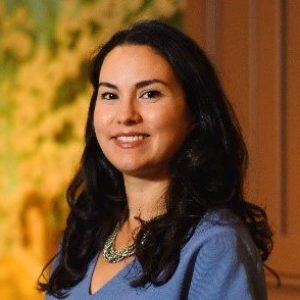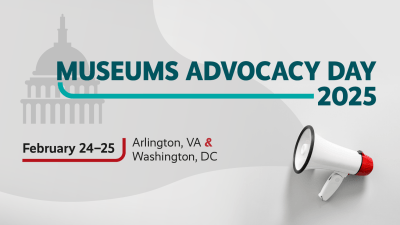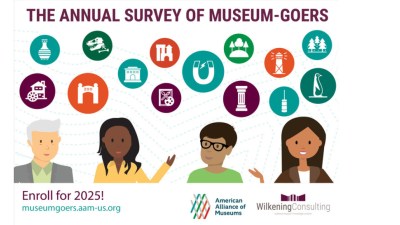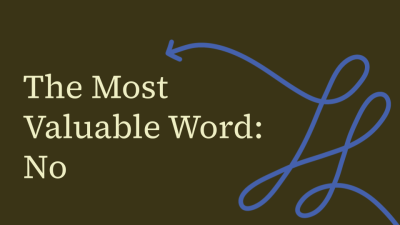
In March 2020, I gave birth to my second child, just two months after becoming the Delaware Art Museum’s Interim Executive Director and days into the COVID-19 lockdown.
In those early weeks, I naively thought I could hunker down in my quasi-maternity leave and keep all the plates spinning, pushing the anxiety and uncertainty to the far reaches of my mind. But that mentality was short-lived. And with the acceptance that the pandemic was not a temporary pause but a major societal shift—some of it for the better, much of it devastating for so many—I began to think differently about my life priorities.
You may not have had a baby in spring 2020, but I bet you had a unique challenge to overcome. Perhaps you were caring for an immunocompromised parent, or maybe you were managing remote school for anxious adolescents. Or you were struggling to work from home in your apartment while navigating the immense mental toll of social isolation.
Whatever your circumstance, you were probably reordering your life priorities, too. And the conclusion many of us have come to is that we want to live our lives with more care and intention. More time with family and loved ones; more autonomy so we can be our most productive selves at work; more focus on the mission-related outcomes that drew us to museum work in the first place; more commitment to making our beloved institutions more equitable, inclusive, and accessible for all; and a more clear-eyed assessment of the value of our labor.
Skip over related stories to continue reading articleOrganizations are taking notice. Flexible work policies rolled out as new variants battered our communities. Pay was raised, equity plans were drafted, and unions formed. The phrase “self-care” became almost as ubiquitous as “pivot.”
Hopefully, this is just the beginning of a field-wide discussion around how museums can better support the needs of our staffs. This topic is urgent. Much of our sector is built upon unstainable frameworks, such as project timelines that de-prioritize work-life balance, funders who will invest in programmatic costs but not staff to support those projects, and low salaries that force talented people out of the field. Calls for change can’t rest on the staff who experience these challenges most acutely. These discussions need to come from the top of our organizations, in partnership with the staff members who make our missions possible.
I don’t have a silver bullet for these widespread structural challenges, but I can tell you the steps DelArt is taking now to create and nurture a positive, people-centered culture. And I will share my vision for how we can work together as a field for a healthier, more sustainable future.
Starting with empathy: As I mentioned above, each of us is grappling with unique challenges that have likely impacted our ability to work as we once had. This requires that we acknowledge one another’s human needs ahead of our productivity. More than ever, we must give our colleagues the benefit of the doubt when an email slips through the cracks or a deadline isn’t met as expected. It is imperative that we consider good intentions and offer support as we build stronger, more resilient workplace cultures that center and value the unique contributions that each person brings to our organizations. At DelArt, we have leaned on the Empathetic Museum collective to accomplish this, bringing them in for staff trainings, using their Maturity Model to guide our strategic planning, and treating their teachings as a constant reminder to inform our day-to-day relationships and communications.
Making sure strategy and finances are clear and transparent: Financial and strategic transparency across all levels of staff is good practice in times of crisis and stability. However, it is also one of the hardest things to do effectively in any organization, especially in complex institutions like museums. But it is essential that we align our strategic, inclusion, and financial plans and spend time talking openly about what we value, what’s working, and what isn’t.
Focusing on basic needs: A clear strategy and strong, supportive tone are an important foundation, but no culture can thrive without addressing basic needs. Paid family leave, a livable wage, and support for flexible work can help employees meet these.
At DelArt, we implemented a paid family leave policy as soon as I returned from my maternity leave. And, like many museums, we have also added flexible scheduling where possible that balances our operational needs with the needs of individual staff members. These are the first steps to supporting working parents, who have shouldered an outsized burden throughout the pandemic disruptions.
Pay and COVID-19 safety protocols have also been critical changes. We recently ended our contract with a third-party security company and hired a team of in-house Museum Ambassadors, trained staff who are a welcoming presence in our galleries. As part of this change, we raised minimum pay for our employees. Our board was not only supportive of this decision, but several members—including our board president—continue to be vocal advocates for livable wages.
Although our city and state never implemented a vaccine mandate, we were one of the first in Delaware to require vaccines for staff, volunteers, and visitors. We listened to our staff, especially our frontline team, in making this decision, which was implemented in September 2021 and ended in mid-March.
I want to pause here and acknowledge that raising pay and implementing a vaccine mandate are complex decisions that require board member buy-in and political maneuvering both inside and outside your organization. After all, we are mission-based organizations that can’t discount the political forces that shape our communities—and our funding. But museums are inherently complex organizations. Museum leaders step into these roles understanding that we are navigating competing beliefs, desires, and realities. This leads me to my next topic: advocacy.
Embracing advocacy: As museum leaders, one of our jobs is to understand the local systems, structures, and sources of power that underpin our communities. A lot of us tend to acknowledge and loosely integrate ourselves into these systems, but then stop short of trying to reshape them. The latter can be tricky, as museums serve as safe spaces for people across political divides, but there are many issues in which museums can and should be outspoken leaders in their communities. As sophisticated organizations within philanthropic ecosystems, we can speak with local funders about making their funding processes more inclusive. We can educate our elected leaders on how the creative workforce is providing essential labor that is a foundation for a thriving economy. AAM’s advocacy page has a list of resources and topics to speak up about. But before brainstorming content and contacts comes the hard work of acknowledging and accepting this role.
Rethinking how you hire and develop employees: When I first started at DelArt more than a decade ago, the institution had a more narrowly defined focus on its role in the community, which did not align with my interest in public service. DelArt’s focus has changed, which enabled me to grow my strongest skills as opposed to trying to mold myself into something that didn’t quite fit.
I’m thrilled to see the sector more fully embrace this mindset. It’s exciting to watch museums build stronger teams by welcoming in people with different life and work experiences and educational backgrounds. Diverse perspectives make our organizations more resilient and creative, and they also push museums to think deeply about our relevance within our communities.
At DelArt, we are rethinking both how we recruit candidates and how we develop employees. We are removing unnecessary requirements from job descriptions and looking beyond our field for candidates. We are also focusing more on developing internal staff and creating new pipelines for their advancement. We have long offered professional coaching to our employees, but we are now looking more deeply at unrecognized expertise they may have and actively nurturing their career advancement. A recent example is our Community Engagement Specialist, who was formerly an Operations Technician, but had decades of experience in community organizing that lent themselves to a role in the Learning & Engagement Department. Similarly, we will begin providing new frontline staff, such as the Museum Ambassadors and our Museum Educators, opportunities to learn about different parts of the organization, interact with fellow staff, and grow in their careers.
Creating a culture of learning from one another: Museums are making great progress breaking down traditional structures and silos, which ultimately helps people across the organization learn from one another. At DelArt, we are constantly trying to facilitate this process. We intentionally pair people from different parts of the organization to build understanding and relationships. To date, this has ranged from changing the format of our all-staff meetings to begin with randomly assigned Zoom breakout groups to assembling teams of cross-departmental, mixed-level staff to lead our institutional strategic planning. The relationships between us are our strongest asset, and we are excited to continue building dialogue across the organization.
Sweating the small stuff (sometimes): Leaders are often focused on large, structural changes, but we can’t lose sight of the day-to-day needs in our organizations in the process. For example, scheduling and staffing changes last year prevented our frontline team from receiving timely program updates, which put them in the difficult situation of responding to visitor questions before they could be briefed on the relevant information. What might have been interpreted as a small mistake instead created a demoralizing disruption for this team, who take pride in creating an exceptional visitor experience. A people-centered culture won’t work if daily stressors and indignities like these aren’t taken seriously. And sometimes taking it seriously requires a policy of accountability.
Prioritizing accountability: As a woman, I have been in the position of having to brush aside an uncomfortable interaction at work. For many in our industry, those interactions are magnified by their position within a museum, and also intersect with race, gender, physical ability, and sexual orientation. At my first (non-museum) professional job, I experienced sexual harassment. I blamed myself for these interactions and felt a high degree of shame that I hadn’t been able to work around the offending person more competently. But it was the leaders who saw what was happening and did nothing who should be ashamed.
Our sector has a lot of work to do to eliminate the bullying, harassment, and microaggressions that many experience in all levels of staff, volunteer, and visitor interactions. No policy will reshape a dynamic that is entrenched across many industries in our society, but leaders and managers must get better at addressing these behaviors when we see them. At DelArt, we are just beginning this journey, with codes of conduct that outline the expectation of respectful behavior in detail. Now we begin the hard work of documenting and taking consistent action on those stated guidelines. I know many other museums are embarking on this process; I hope it will be a larger topic of conversation as we work toward the shared goal of safe workspaces.
Continued Work
At first, I hesitated to write this article because our work to transform internal culture isn’t done yet. The actions we’ve taken are the obvious first steps, and we still have deeper work to do. But I believe my job as an executive director is to thread the needle on issues that feel impossibly opposed. Meet the mission with fewer resources. Value and support talented staff while funding amounts haven’t even come close to keeping pace with inflation. Unify progressive staff members and cautious trustees. And above all, ensure that the organization I steward reflects and demonstrates the values we uphold.
Upheaval is hard, but out of extraordinary times come important opportunities for progress. Across our industry, many of us are dedicated to making our organizations more equitable and inclusive, expanding audiences, diversifying power structures, and thinking critically about new financial models. DelArt has faced several crises in recent years, and each time we have come through stronger and more committed to our mission. The pandemic has given us the opportunity to immediately support staff by raising salaries, adding benefits like paid parental leave and flexible work options, and prioritizing empathy in our internal relationships. But larger structural changes will take time and depend on strengthening and diversifying funding. We are investing in emerging staff who, I believe, will effect change in museums throughout their careers. We are piloting revenue-generating, mission-aligned projects and partnerships that may take years to take off. And while we have been successful in broadening DelArt’s audiences, we are still working to diversify our revenue and philanthropic sources.
Being a people-centered organization where challenges are discussed openly is central to our values. For me to live those values fully, I knew I needed to share DelArt’s imperfect efforts to improve workplace culture. I encourage other executive directors to embrace vulnerability by sharing how they are tackling these issues, as well as the challenges our field has yet to confront. We need to share the models for making change as we build them, and to have an open dialogue about our common roadblocks. I look forward to working together to rebuild our museum cultures in alignment with our inclusive values.









Thank you so much for this article! We are reading this blog in a graduate course at the University of Kansas as part of ongoing discussions through the Museum Studies department.
Molly, thanks for being vulnerable and sharing the work you’re team is doing there at your museum. It’s good to hear about these changes, and I hope other directors can see that becoming more human-centered is entirely possible and real.